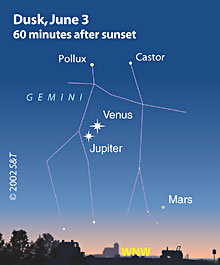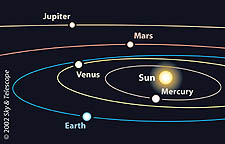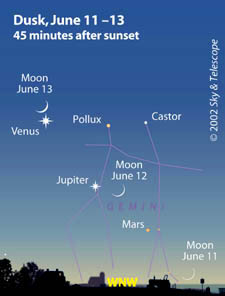May 31, 2002
Contacts:
J. Kelly Beatty, Executive Editor
855-638-5388 x148, [email protected]
Roger W. Sinnott, Senior Editor
855-638-5388 x146, [email protected]
Note to Editors/Producers: This release is accompanied by three publication-quality illustrations; see details below.
Don't be alarmed by those two gleaming beacons in the evening sky this week. It's not a pair of UFOs or some strange military test — it's Venus and Jupiter putting on a celestial show. The two brightest planets have been gradually drawing together over the past few weeks, just one aspect of a rare planetary gathering that has graced our evening skies since late April.
Venus and Jupiter will cap off the planet parade with an eye-catchingly close pairing after sunset on June 3rd, when they'll appear just a bit more than 1½° apart, the width of your index finger at arm's length. We see them side by side in the sky thanks to a line-of-sight alignment across interplanetary space. In reality these two worlds are separated by more than 700 million kilometers (440 million miles).
Much fainter Mars is situated about a fist's width to their lower right, virtually invisible in the twilight glow. Saturn and Mercury are now hopelessly immersed in bright glare near the Sun.
Close encounters, or conjunctions, of Venus and Jupiter occur roughly every year, and sometimes they're breathtakingly narrow misses. In February 1999, for example, the two planets were only 0.15° apart (one-third the width of a full Moon), and on June 17, 2 B.C., the two appeared to merge into a single, bright beacon that may have served as the Star of Bethlehem.
These two planets gleam so brightly — outshining every nighttime star — because their clouds reflect sunlight very well. Since it orbits so much closer to the Sun, right now Venus appears nearly seven times brighter than Jupiter. When seen through a telescope, Venus's disk is white and featureless, while Jupiter sports faint light and dark bands and a quartet of pinpoint satellites.
Another eye-catching celestial treat occurs 10 days later, on the evening of June 13th, when a slender, three-day-old crescent Moon will be situated about 2° above Venus in the rosy twilight glow. This very close pairing should provide a beautiful subject for a camera equipped with a long-focal-length (telephoto) lens.
Stargazers worldwide can use Sky & Telescope's Interactive Sky Chart to simulate the planetary parade as seen from their particular location. For example, click on the following link to simulate the sky as seen from Miami, Florida, at 8:50 p.m. Eastern Daylight Time on June 3rd, the night Venus and Jupiter are closest together: view sky chart.
Published in Cambridge, Massachusetts, Sky & Telescope has been a respected, authoritative source of up-to-date information about astronomy and space science since 1941. Each monthly issue is read by 200,000 astronomy enthusiasts worldwide, from the novice looking for a first telescope to the professional desiring to keep up with this dynamically changing field.
Sky & Telescope is making the following illustrations available to the news media. Permission is granted for one-time, nonexclusive use in print and broadcast media, as long as appropriate credits (as noted in each caption) are included. Web publication must include a link to SkyandTelescope.com.
Click on each image to download a high-resolution version.

After sunset on June 3rd, Venus and Jupiter will appear a finger's width apart in the western sky. Above them are the stars Pollux and Castor, the 'Twins' of Gemini, while dim Mars lurks lower down in the twilight glow.
Sky & Telescope diagram.

On June 3rd, Venus and Jupiter appear very close together in the sky because, from Earth's perspective, they're positioned along nearly the same line of sight. Mars appears closer to the Sun in the sky, while Mercury is hopelessly lost in solar glare.
Sky & Telescope diagram.

When dusk arrives on June 12th, a very delicate crescent Moon will be sitting just to the right of Jupiter. One night later, the crescent will have moved to a point about 2° above the bright planet Venus, creating a dramatic pairing.
Sky & Telescope diagram.
 0
0
Comments
You must be logged in to post a comment.